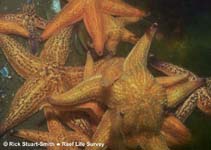Asterias amurensis Lütken, 1871
North Pacific seastar
Classification / Names Populärnamn | synonymer | CoL | ITIS | WoRMS
Asteroidea | Forcipulatida | Asteriidae
Environment: milieu / climate zone / djupintervall / distribution range Ekologi
; djupintervall ? - 200 m (Ref. 76803). Temperate; 7°C - 22°C (Ref. 76803)
Distribution Länder | FAO områden | Ekosystem | Förekomster | Utplanteringar
Northern Pacific and the Arctic. Temperate to polar.
Length at first maturity / Size / Weight / Age
Könsmognad: Lm ? range ? - ? cm Max length : 50.0 cm WD hane/ej könsbestämd; (Ref. 76803)
Life cycle and mating behavior Könsmognad | Reproduktion | Lek | Eggs | Fecundity | Larvae
Main reference
referenser | Koordinator | Medarbetare
Ross, D.J., C.R. Johnson and C.L. Hewitt 2006 Abundance of the introduced seastar, Asterias amurensis, and spatial variability in soft sediment assemblages in SE Tasmania: Clear correlations but complex interpretations. Estuarine, Coastal and Shelf Science 67:695-707. (Ref. 8004)
IUCN Red List Status
(Ref. 130435: Version 2025-1)
CITES status (Ref. 108899)
CMS (Ref. 116361)
Threat to humans
Human uses
| FishSource |
Verktyg
Ytterligare information
Födosammansättning
Födointag
Predatorer
Max. ages / sizes
Length-weight rel.
Length-length rel.
Length-frequencies
Mass conversion
Abundans
Internet-källor
BHL | BOLD Systems | CISTI | DiscoverLife | FAO(Publication : search) | Fishipedia | GenBank (genome, nucleotide) | GloBI | Gomexsi | Google Books | Google Scholar | Google | PubMed | Tree of Life | Wikipedia (Go, sök) | Zoological Record



